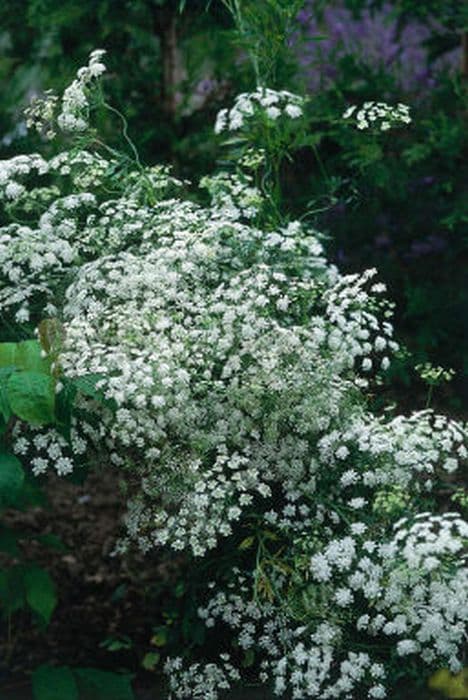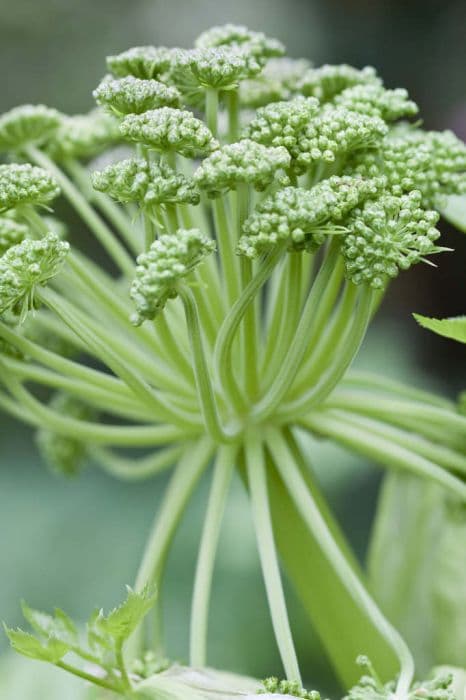Great masterwort Astrantia major 'Large White'

ABOUT
Astrantia major 'Large White', commonly known as Great Masterwort, is a perennial plant with a charming and intricate appearance that is highly valued in garden settings for its unique flower structure and foliage. The plant features a beautiful rosette of lobed, palmate leaves that are typically green and can have a slightly shiny surface, creating a lush, textural ground cover when not in bloom. Dominating its visual display, Great Masterwort produces striking flowers. Each flower is composed of a cluster of tiny, star-shaped blooms that nestle together, creating a pincushion-like effect. These are subtended by a ruff of papery bracts that can often be mistaken for petals. The star of this variety, 'Large White', is its bloom color—pristine white flowers that emerge in the late spring to summer, providing a crisp, clean look in the garden. The contrast between the white flowers and the fresh green foliage creates a serene and somewhat romantic aesthetic. These blooms are not only visually appealing to human admirers but are also attractive to pollinators, such as bees and butterflies, which find the tiny florets a rich source of nectar. Adding to the allure of the Great Masterwort is its resilience and hardiness, making it a favored choice for gardeners seeking a striking plant that has a long flowering period and comes back year after year. With its delicate beauty and long-lasting appeal, Astrantia major 'Large White' is a choice specimen for cottage gardens, borders, and floral arrangements.
About this plant
 Names
NamesFamily
Apiaceae
Synonyms
Great Masterwort, Large White Masterwort
Common names
Astrantia carniolica, Astrantia colchica, Astrantia helleborifolia, Astrantia intermedia, Astrantia lucida, Astrantia major, Astrantia maxima, Astrantia minor, Astrantia palmata, Astrantia rotundifolia
 Toxicity
ToxicityTo humans
Astrantia major 'Large White', commonly known as Great Masterwort, is not considered toxic to humans. There is no well-documented evidence of poisoning from ingesting this plant, and it does not typically cause adverse reactions if handled or consumed in small quantities. However, as with any plant material, individual sensitivity can vary, and it's always advisable to avoid ingesting plants not meant for consumption.
To pets
Great Masterwort is not known to be toxic to pets. There is no significant evidence suggesting that ingestion of this plant by dogs, cats, or other domestic animals causes poisoning or serious health issues. Nonetheless, pet owners should still practice caution and prevent pets from consuming non-food plants as a general safety measure, as individual reactions can vary.
 Characteristics
CharacteristicsLife cycle
Perennials
Foliage type
Deciduous
Color of leaves
Green
Flower color
White
Height
2 feet (61 cm)
Spread
1.5 feet (45 cm)
Plant type
Herb
Hardiness zones
5
Native area
Europe
Benefits
 General Benefits
General Benefits- Attracts Pollinators: Astrantia major 'Large White' is known for its ability to draw in bees, butterflies, and other beneficial pollinators, enhancing pollination in your garden.
- Low Maintenance: It requires minimal care once established, making it ideal for gardeners seeking low-maintenance plants.
- Drought Tolerant: Once established, it can tolerate periods of drought, reducing the need for frequent watering.
- Long Flowering Period: The plant blooms for an extended period, often from early summer to late fall, offering prolonged interest in the garden.
- Deer Resistant: It's not palatable to deer, making it suitable for gardens in areas where deer browsing is a problem.
- Cottage Garden Appeal: With its classic white flowers and cottage garden charm, it is perfect for traditional garden designs.
- Cut Flowers: The flowers are ideal for cutting and use in floral arrangements, adding beauty both in the garden and as part of indoor décor.
- Versatile Planting: Suitable for borders, woodland plantings, and as part of mixed flower beds, demonstrating versatility in garden design.
- Architectural Interest: It provides architectural interest with its distinctive bract-enclosed blooms and mounded form.
- Seasonal Color: Adds a splash of color when many other plants have finished blooming, especially important in late summer and autumn gardens.
 Medical Properties
Medical PropertiesThis plant is not used for medical purposes.
 Air-purifying Qualities
Air-purifying QualitiesThis plant is not specifically known for air purifying qualities.
 Other Uses
Other Uses- Astrantia major 'Large White' can be used in dried floral arrangements, as the flowers retain their shape and color when dried, adding aesthetic appeal to the composition.
- The Masterwort's roots have been used traditionally to produce natural dyes, with the potential of yielding colors in the yellow to brown range for textiles.
- Its stems can be incorporated into basketry and other weaving projects for an organic, textured look, especially in folk crafts.
- The plant is often used in companion planting to attract beneficial insects like bees and butterflies, thus supporting surrounding vegetation.
- As a part of a rain garden, Masterwort helps in water management by allowing water to infiltrate the soil, reducing runoff and erosion.
- It can be used as an educational tool in horticultural therapy settings, helping participants learn about plant lifecycle and care.
- Masterwort may serve as a natural pest repellent when planted in a mixed border, due to its distinct aroma that some pests find off-putting.
- In landscape design, it's used to create a 'ghost garden' effect with its pale flowers glowing in the twilight, enhancing the garden's night-time appeal.
- Photographers and artists may utilize Masterwort as a subject for their work due to its intricate flower structure and visual interest.
- When included in wildlife gardens, the plant provides habitat and food for caterpillars of certain butterfly species.
Interesting Facts
 Feng Shui
Feng ShuiThe Great Masterwort is not used in Feng Shui practice.
 Zodiac Sign Compitability
Zodiac Sign CompitabilityThe Great Masterwort is not used in astrology practice.
 Plant Symbolism
Plant Symbolism- Grace - Astrantia represents grace due to its subtle beauty and charming floral patterns.
- Protection - It is historically believed to have protective qualities, thought to drive away negative energies when planted around homes.
- Strength - Despite its delicate appearance, Astrantia is a resilient plant, symbolizing strength and endurance.
- Unity - The clustered flowers of Astrantia symbolize unity and togetherness, reflecting how multiple parts come together to make a whole.
 Water
WaterThe Great Masterwort should be watered thoroughly once the top inch of soil feels dry to the touch. In a garden setting, this typically translates to about 1 inch of water per week, either from rainfall or manual watering. Adjustments should be made during hot, dry periods, where supplemental watering may be necessary to maintain consistent moisture. Overwatering should be avoided to prevent root rot; always ensure that the soil has good drainage. During winter months, reduce watering as the plant enters a dormant state and requires less moisture.
 Light
LightThe Great Masterwort thrives best in partial shade but can also tolerate full sun if the soil is kept consistently moist. The ideal spot for this plant is one where morning sunlight can reach it and afternoon shade protects it from the intense heat of the day. Filtered sunlight beneath a canopy of deciduous trees can also provide the suitable light conditions this plant prefers.
 Temperature
TemperatureThe Great Masterwort performs well in a wide range of temperatures, generally preferring conditions between 60 to 75 degrees Fahrenheit. It can tolerate a minimum temperature down to about 20 degrees Fahrenheit, allowing it to survive typical winter conditions. However, it's imperative to protect the plant from extreme cold and heat, as temperatures below 20 degrees Fahrenheit or above 80 degrees Fahrenheit could cause damage.
 Pruning
PruningPruning Great Masterwort is essential for promoting vigorous growth and flowering. Deadheading spent flowers encourages new blooms and prevents self-seeding if desired. Cut back the foliage in late fall or early winter, after the plant has finished blooming and the leaves have yellowed. Pruning can be done annually to maintain a tidy appearance and rejuvenate the plant for the coming spring.
 Cleaning
CleaningAs needed
 Soil
SoilGreat Masterwort requires a soil mix that is rich in organic matter with good drainage. A mix of loam, peat, and coarse sand is suitable. The soil pH should be slightly acidic to neutral, in the range of 5.5 to 7.5.
 Repotting
RepottingGreat Masterwort does not need frequent repotting; it can be repotted every 2-3 years, or when it outgrows its current container.
 Humidity & Misting
Humidity & MistingGreat Masterwort thrives best in moderate humidity levels but is quite adaptable and does not require strictly controlled humidity.
 Suitable locations
Suitable locationsIndoor
Provide bright indirect light, and ensure the soil is moist.
Outdoor
Plant in partial shade, in moist, well-drained soil.
Hardiness zone
4-7 USDA
 Life cycle
Life cycleThe Great Masterwort 'Large White' begins its life as a seed, germinating in the spring when soil temperatures rise and moisture is sufficient. After germination, it develops a rosette of lobed, palmate leaves close to the ground. As the plant matures, it sends up flowering stems in late spring to early summer, which bear clusters of small, white flowers surrounded by a ruff of showy white bracts. Following pollination, often by bees and other insects attracted to the flowers, the plant produces seed heads that mature through the summer. Seeds are dispersed late summer or fall, completing the reproductive cycle. The Great Masterwort 'Large White' is a herbaceous perennial, so after flowering, the above ground parts die back in the fall, and the plant overwinters as dormant root stock, ready to regrow the following spring.
 Propogation
PropogationPropogation time
Early Spring
The most popular method of propagation for Astrantia major 'Large White', commonly known as Great Masterwort, is by division. The best time for dividing this perennial is in either early spring or early fall, when the plant is not in active bloom. To propagate by division, carefully dig up the plant, making sure to keep a good amount of soil around the roots. Gently tease apart the clump into smaller sections, ensuring that each new section has a portion of the root system intact. Replant the divisions at the same depth they were originally growing, spacing them about 18 inches (approximately 46 centimeters) apart to allow room for growth. Water the new divisions thoroughly to help establish them. This straightforward approach encourages healthy new plants that are exact replicas of the parent and will usually bloom within the next growing season.









